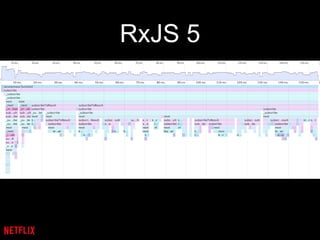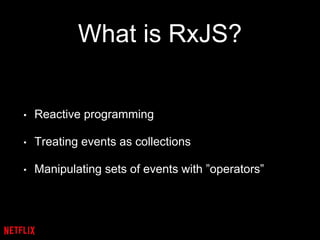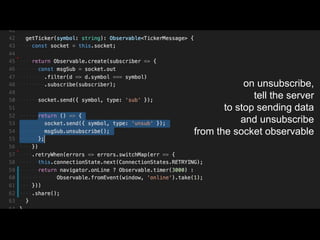RxJS In-Depth - AngularConnect 2015
- 1. RxJS In-Depth (Formerly a talk called “Reactive Streams in Angular 1 and 2”)
- 2. We had a last-minute pivot on talk content, because Jeff Cross and Rob Wormald wanted to ruin my week last week.
- 3. Ben Lesh Senior UI Engineer Edge Developer Experience
- 5. “RxJS Next” is now RxJS 5.0.0-alpha
- 6. RxJS 5 is community driven Spear-headed by contributors at Netflix, Google and Microsoft. With many other contributors under the ReactiveX community banner.
- 7. RxJS 5 Goals • Performance • Improved debugging • ES7 observable spec alignment
- 8. Performance • Decisions were guided by performance testing • Tried out 4-5 different architectures in the beginning • > 120 micro performance tests • ~ 10 macro performance tests around common scenarios and bottlenecks
- 9. RxJS 5 operators are 4.3x faster on average
- 10. Call-stack depth and debugging was a common complaint in older versions of RxJS
- 11. RxJS 4
- 12. RxJS 5
- 13. Thanks in huge part to contributions from Paul Taylor OJ Kwon André Staltz Jeff Cross
- 14. … really every one of our contributors. https://github.com/ReactiveX/RxJS/graphs/contributors
- 15. Thanks to guidance from Matt Podwysocki Jafar Husain Erik Meijer Ben Christensen George Campbell Aaron Tull
- 16. we’re closing in on beta in the next month or so
- 17. What is RxJS? • Reactive programming • Treating events as collections • Manipulating sets of events with ”operators”
- 18. “RxJS is LoDash or Underscore for async.”
- 19. Angular 2 is using RxJS 5 Observables for async
- 20. Angular has traditionally used Promises for async
- 21. Promises • Read-only view to a single future value • Success and error semantics via .then() • Not lazy. By the time you have a promise, it’s on its way to being resolved. • Immutable and uncancellable. Your promise will resolve or reject, and only once.
- 22. Observable • “Streams” or sets • Of any number of things • Over any amount of time • Lazy. Observables will not generate values via an underlying producer until they’re subscribed to. • Can be “unsubscribed” from. This means the underlying producer can be told to stop and even tear down.
- 23. Both Promises and Observables are built to solve problems around async (to avoid “callback hell”)
- 24. Types of async in modern web applications • DOM events • Animations • AJAX • WebSockets • SSE • Alternative inputs (voice, joystick, etc)
- 25. Promises only really make sense for one of these • DOM events (0-N values) • Animations (cancelable) • AJAX (1 value) • WebSockets (0-N values) • SSE (0-N values) • Alternative inputs (0-N values)
- 26. … except when they don’t • Single page applications commonly prepare data via AJAX for each view shown • When the view changes, the next view probably doesn’t care about the previous view’s data • Fortunately, XHRs can be aborted! • …but promise-based AJAX implementations cannot be aborted, because promises cannot be cancelled.*
- 27. So how do we go from Promises to Observables?
- 28. They have some similar semantics then x. (valueFn, errorFn);subscribe
- 29. They have some similar semantics x.subscribe(valueFn, errorFn);, completeFn
- 30. Observable also has cancellation semantics! let sub = x.subscribe(valueFn, errorFn, completeFn); // ...some time later sub.unsubscribe();
- 31. Creating Observables is similar to creating Promises
- 32. creating a Promise let p = new Promise((resolve, reject) => { doAsyncThing((err, value) => { if (err) { reject(err); } else { resolve(value); } }); });
- 33. creating an Observable let o = new Observable(observer => { doAsyncThing((err, value) => { if (err) { observer.error(err); } else { observer.next(value); observer.complete(); } }); });
- 34. if the producer’s resource allows cancellation, we can handle that here let o = new Observable(observer => { const token = doAsyncThing((err, value) => { if (err) { observer.error(err); } else { observer.next(value); observer.complete(); } }); }); const token return () => { cancelAsyncThing(token); };
- 35. when you call o.subscribe() let o = new Observable(observer => { const token = doAsyncThing((err, value) => { if (err) { observer.error(err); } else { observer.next(value); observer.complete(); } }); return () => { cancelAsyncThing(token); }; }); observer => { const token = doAsyncThing((err, value) => { if (err) { observer.error(err); } else { observer.next(value); observer.complete(); } }); return () => { }; });
- 36. when you call subscription.unsubscribe() let o = new Observable(observer => { const token = doAsyncThing((err, value) => { if (err) { observer.error(err); } else { observer.next(value); observer.complete(); } }); return () => { cancelAsyncThing(token); }; }); return () => { cancelAsyncThing(token); };
- 37. Don’t worry... you’re unlikely to be creating your own Observables
- 38. Observable creation helpers in RxJS • Observable.of(value, value2, value3, …) • Observable.from(promise/iterable/observable) • Observable.fromEvent(item, eventName) • Angular’s HTTP and Realtime Data services • Many community-driven RxJS modules and libraries
- 39. Error Handling in Observables is also similar to Promise
- 40. catch myPromise.catch(error => { if (error instanceof OkayError) { return Promise.resolve(‘okay’); } else { throw error; } });
- 41. catch myObservable.catch(error => { if (error instanceof OkayError) { return Observable.of(‘okay’); } else { throw error; } });
- 42. finally (some promise impls) myPromise.finally(() => { console.log(‘done’); });
- 44. Observables can be “retried” myObservable.retry(3); myObservable.retryWhen(errors => errors.delay(3000));
- 45. Quick Recap on Observable An observable is a set of any number of things over any amount of time.
- 46. Quick Recap on Observable All values are pushed to the nextHandler observable.subscribe(nextHandler);
- 47. Quick Recap on Observable The errorHandler is called if the producer experiences an error observable.subscribe(nextHandler, errorHandler);
- 48. Quick Recap on Observable The completionHandler is called when the producer completes successfully observable.subscribe(nextHandler, errorHandler, completionHandler);
- 49. Quick Recap on Observable Observables are lazy. It doesn’t start producing data until subscribe() is called. observable.subscribe(nextHandler, errorHandler, completionHandler);
- 50. Quick Recap on Observable subscribe() returns a subscription, on which a consumer can call unsubscribe() to cancel the subscription and tear down the producer let sub = observable.subscribe(nextHandler, errorHandler, completionHandler); sub.unsubscribe();
- 51. What are “operators”? They’re methods on Observable that allow you to compose new observables.
- 52. How operators work let result = source.myOperator(); result is an Observable, that when subscribed to, subscribes to source, then tranforms it’s values in some way and emits them.
- 53. How operators work subscription.unsubscribe(); when unsubscribe() is called on that subscription, the unsubscription logic from both result and source are called.
- 54. How operators work • Operators pass each value from one operator to the next, before proceeding to the next value in the set.* • This is different from array operators (think map and filter) which will process the entire array at each step. • *This can be changed with Schedulers.
- 55. Array filter, map, reduce
- 56. Observable filter, map, reduce
- 57. simple operators • map() • filter() • reduce() • first() • last() • single() • elementAt() • toArray() • isEmpty() • take() • skip() • startWith() • and many more…
- 58. merging and joining operators • merge • mergeMap (flatMap) • concat • concatMap • switch • switchMap • combineLatest • withLatestFrom • zip • forkJoin • expand
- 59. splitting and grouping operators • groupBy • window • partition
- 60. buffering strategy operators • buffer • throttle • debounce • sample
- 61. With ES7 function bind, you can roll your own* (*coming soon to TypeScript?)
- 62. “hot” vs “cold” observables • Observables are “cold” by default • “Cold” observables create a new producer each time a consumer subscribes to them • “Hot” observables share a single producer with every consumer that subscribes to them.
- 63. Multiplexed WebSocket • Connect to a web socket server • For each data stream • send a subscription message to the server • filter out responses from the server • when done, send an unsubscription message. • Ideally, the socket is only open while you require data from it.
- 64. Multiplexed WebSocket • RECONNECTION?! • maintain a state of all of the multiplexed data streams your views need. • check to see when you’re able to reconnect • reconnect the socket • once the socket is reopened, send all of the subscription messages again
- 65. Create an Observable that wraps a WebSocket
- 66. It will create the WebSocket when you subscribe()
- 67. It emits messages events that arrive on the WebSocket
- 68. And when it unsubscribes, it will tear down the WebSocket!
- 69. “Share” to make it “hot”… We don’t want each subscription creating it’s own websocket.
- 70. Create an Observable that wraps our Socket Observable
- 71. filter the messages from the Socket Observable to what you need and subscribe
- 72. Send a message to the server to start getting the data over the socket
- 73. on unsubscribe, tell the server to stop sending data and unsubscribe from the socket observable
- 74. Add a retryWhen to retry the whole thing if something goes wrong with the multiplexed observable
- 75. “share” the observable to make it “hot”, so many consumers can share this producer.
- 76. Example Time!
- 77. Never trust anyone with only good things to say about their library/framework.
- 78. What’s bad in RxJS? • “Zalgo”.. don’t use mutable outer scoped variables in your operators or subscriptions! • Unbounded buffers! The zip operator in particular is dangerous here. • Too many operators to remember.
- 79. Twitter: @benlesh github: blesh [email protected] GOOD: Comments. BETTER: Questions. BEST: Corrections! Thank you!
Editor's Notes
- #14: Luis Gabriel Adrian Omelo Jinroh Rob Wormwald















































































